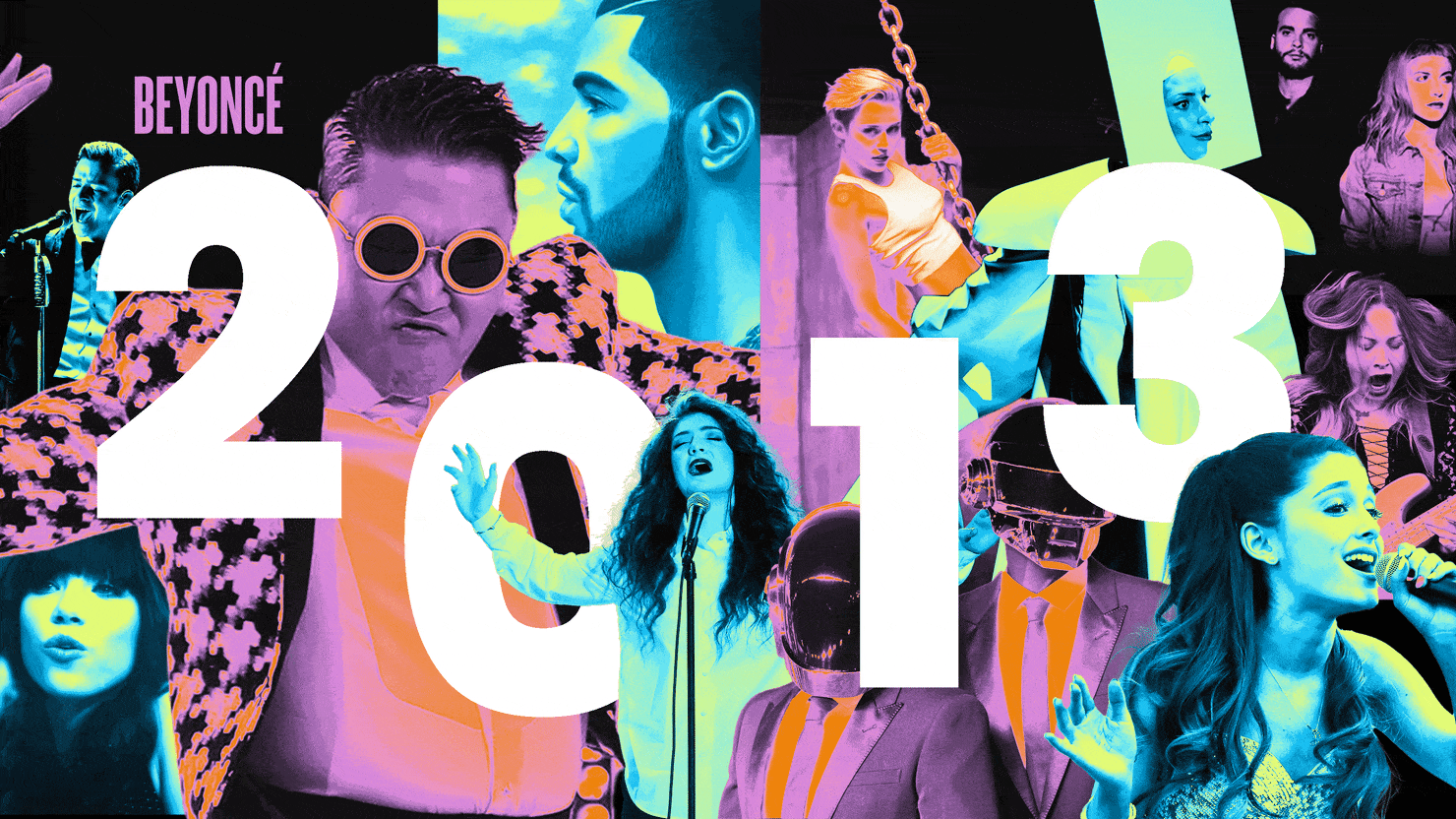Ten years ago, pop music was at its finest and busiest. Whether you were rocking out to certified bangers like Kesha and Pitbull’s “Timber,” partaking in a not-at-all-embarrassing “Harlem Shake” video with your friends, browsing through posts on Hipster Runoff right before its untimely end, or gawking at Miley’s infamous VMA performance, 2013 was the most consequential year for esteemed and emerging pop artists in recent memory, producing a massive ripple effect on how we talk about, think about, distribute, and listen to music today.
Along with a string of chart-topping, radio-friendly hits from unexpected acts like Macklemore and Robin Thicke, the year was most notable for bearing a vibrant slate of star-making albums from up-and-comers-turned-current pop icons.
There was Victorious actress Ariana Grande, who broke out of her Nickelodeon shell with her warm, mature debut album, Yours Truly, and its Mariah Carey-inflected lead single, “The Way.” Indie darling Sky Ferreira delivered on her much-hyped major label debut Night Time, My Time after breaking out with the beloved “Everything is Embarrassing” the year prior. Lorde was only 17 when she made Pure Heroine, a sleek and gothy sonic collage of teen angst that became a blueprint for future stars like Clairo and Billie Eilish. Coming off a feature on Icona Pop’s “I Love It,” Charli XCX transformed from a rave MySpace kid into a pop prophet with True Romance. L.A.-based sister trio HAIM got their big break with Days Are Gone, as did Scottish synth-pop outfit CHVRCHES with The Bones of What You Believe and British rock band The 1975 with their self-titled LP.
The year also yielded a few culturally momentous, sonically experimental works from already well-established artists. Big names in the mainstream and indie pop spheres, like Paramore, Drake, Arctic Monkeys, and Vampire Weekend, made huge leaps in their respective artistic evolutions, each honing their craft while broadening their scope. Disney Channel star Miley Cyrus pivoted sharply from the sugary teen-pop of her Hannah Montana days to Southern hip-hop with Bangerz, courting controversy for her radical shift in sound and image. Similarly, Lady Gaga received mixed reviews for ARTPOP, a project that caught critics and audiences off guard for its eccentric lyrics and avant-garde instrumentation, but has since been reassessed as one of her most underrated albums.
Elsewhere, 2013 saw a few career comebacks for major artists from the 2000s. After venturing into acting with Bad Teacher, The Social Network, and Friends with Benefits, Justin Timberlake announced his return from a seven-year musical hiatus with The 20/20 Experience, an ambitious, sensual blend of classy neo-soul and Timbaland-infused R&B that became the year’s best-selling album. Following a scoring gig on TRON: Legacy in 2010, the enigmatic French electronic duo Daft Punk reemerged from the shadows with the song of the summer, “Get Lucky,” and their adventurous fourth (and ultimately final) record Random Access Memories; both the song and album went on to score Record and Album of the Year at the 2014 Grammys.
But among many of these breakouts and breakthroughs, no one could have prepared for 2013 to culminate with the surprise overnight release of Beyoncé’s eponymous fifth album on Dec. 13. Serving as her boldest, richest, most career-defining output at the time, Beyoncé marked a significant departure from the artistic expectations around the superstar. It boasted a series of steamy, stormy, sexual tracks like “Drunk in Love,” “Haunted,” and “Blow” (as well as an impeccably produced visual for each song); it invented the lyric “I woke up like this” that would go on to caption “#unfiltered” Instagram selfies for years to come; and it touched on more intimate and political subjects like motherhood, monogamy, and beauty standards. As evidenced by her later efforts, including 2016’s Lemonade and last year’s Renaissance, Bey had her finger on the pulse of contemporary pop, knowing what we needed before we even knew what we needed.
In retrospect, it’s remarkable that one single year was largely responsible for having such a profound impact on the pop music of the 2010s. To be fair, 2014, 2016, and 2017 were seismic years in their own ways, but 2013 was particularly significant for both its abundance of creative milestones and for marking several pivotal turning points in the music landscape.
Firstly, it marked the end of the dubstep-heavy, EDM-influenced pop that dominated the late aughts and ushered in the beginning of the trap-inspired pop era. Trap was already a well-established subgenre of 1990s and 2000s hip-hop, but it wasn’t until producers like DJ Snake, RL Grime, TNGHT, Mike Will Made It, and Bauuer popularized the sound through their work that it made a mainstream crossover into pop. Trap music’s formula—a synth beat, a triplet flow, and volume and pitch modulations—ultimately displaced dubstep’s thick bassline and syncopated rhythm, finding its way onto much of Beyoncé’s aforementioned self-titled record, as well as Gaga’s “Jewels N’ Drugs” from ARTPOP and Katy Perry’s “Dark Horse,” which reached No. 1 on the Billboard Hot 100 by January 2014. Trap’s influence would gradually gain traction over the next decade, spreading across the pop spectrum, from Fetty Wap’s “Trap Queen” and Cardi B’s “Bodak Yellow,” all the way to Lana del Rey’s Lust for Life and Ariana Grande’s Thank U, Next.
In addition to trap, electronic music also played a pivotal role in 2013 pop, especially as it introduced the masses to the production style of the late, great SOPHIE. After releasing the singles “Nothing Was The Same” and “BIPP” in 2013 and receiving critical acclaim for the latter, SOPHIE became an in-demand producer for artists like Madonna, Vince Staples, Charli XCX, and recent Grammy winner Kim Petras, who shouted out SOPHIE in her acceptance speech and credited the artist for paving the way for her success. The Scottish DJ’s glittery, metallic sound design, distorted vocals, and chaotic yet sophisticated synth textures would function as a template for the hyperpop that permeates much of today’s pop music and social media landscape.
The internet itself would in fact also act as a major force in pop production and distribution in 2013 and beyond. The year marked the start of the streaming era, where online services like Spotify offered musicians the ability to upload their own work and gave listeners unprecedented access to an expansive music library. Though its progenitors MySpace and YouTube technically provided those opportunities as well, Spotify’s consolidated interface and specialized playlists made it easier and more accessible for subscribers to discover new artists, even though the artists themselves didn’t profit as much from streaming. As Spotify’s popularity grew and developed competition with Apple Music and Tidal, the streaming model evolved into the main revenue and business metric for the music industry, consequently leading to a decline in digital downloads, physical sales, and radio airplay.
The height of Tumblr’s popularity also happened in 2013, with the website operating as a space where young people could create fanbases around their favorite musicians and congregate to discuss them. If you were especially obsessed with alternative pop groups with a distinct aesthetic like Vampire Weekend, The 1975, Arctic Monkeys, or any other band from the tail end of the “indie sleaze” era, Tumblr was the place to be. That particular moment online held such tremendous, sentimental value in how it exposed people to pop songs and pop culture figures that the site has recently become a nostalgia trip for zillennials such as myself who lived through that time, and for Gen-Z, who’s just now discovering it.
Finally, 2013 was a year where viral videos helped transform previously unknown songs into massive hits. PSY’s “Gangnam Style” and Carly Rae Jepsen’s “Call Me Maybe” catalyzed the trend the year before, but Bauuer’s “Harlem Shake” and the dance that helped popularize it further solidified the internet’s growing cultural power. Each “Harlem Shake” clip would always start with a masked individual grooving suggestively to the intro’s wobbly synths in a room of seemingly oblivious people. Then, as it reached the hard-as-fuck beat drop and simple command of a refrain—“Do the Harlem shake!”—it would jump-cut to everyone dancing wildly for the rest of the video. It was simply inescapable.
After producing over 4,000 YouTube clips and ascending to No. 1 on the Hot 100, the “Harlem Shake” meme’s rapid and widespread circulation completely revamped Billboard’s methodology, using YouTube data as a determining factor in a song’s success. This commercial attention by way of memes would eventually pave the way for artists to achieve recognition via collaborative and frequently imitated viral videos. We often see this phenomenon today on TikTok, the go-to platform for people to connect with each other through song and dance, incidentally making a bop go viral and launching someone from relative obscurity to overnight stardom.
Beyoncé’s album drop at the end of 2013 and the subsequent fervor it sparked online was the cherry on top of the internet’s chokehold over pop music, capping off an extraordinarily innovative year for music on a high note while also setting yet another trend with the now-exhausted surprise album strategy and changing the new album release schedule from Tuesday to Friday. More than anything, though, the release reflected much of what made 2013 such a great year for pop music: the merit of producing a meaningful, boundary-breaking body of work and the communal aspect that came with appreciating it.
Given how drastically the music industry has changed since then, it’s difficult to say where pop music is headed. Though many of the musicians who made their debuts in 2013 have gone on to lead successful careers and influenced newer artists, it seems like people are yearning for pop music of the past because so much of today’s pop feels so middle-of-the-road and calculated. Perhaps the predictability of the modern music market can be chalked up to a need for comfort from all the cultural and global chaos that’s occurred in the past few years. But hopefully, in due time, we’ll get some good fucking food, as we did in 2013.






